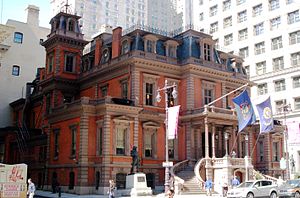Union League


The Union Leagues were quasi-secretive men's clubs established separately, starting in 1862, and continuing throughout the
The Union Leagues were established to promote loyalty to the
The largest and best known of these clubs formed in Philadelphia, New York, and Boston, were composed of prosperous men who raised money for war-related service organizations such as the United States Sanitary Commission, which provided medical care to treat Federal soldiers wounded in battle at a time when the military was ill-prepared for the scale of need.
At the same time as these elite clubs were formed, Union Leagues sprang-up throughout the rest of the North, created primarily by working-class men, while women's organizations known as Ladies Union Leagues appeared in towns across the North. In the spring of 1863 these separate, though (mostly) philosophically aligned groups, were organized under the Union League of America (ULA), headquartered in Washington, D.C.
Postwar
During the
By the end of 1867 it seemed that virtually every black voter in the South had enrolled in the Union League, the Loyal League, or some equivalent local political organization. Meetings were generally held in a black church or school.[1]
The
Philanthropic endeavors

After the Civil War, members of the
Some former Union League buildings have been adapted for other uses. In Brooklyn, New York, the former Union League Club building now serves as a senior citizens' home.
See also
- Union League of Philadelphia
- Union League Club of Chicago
- Union League Club of New York
- Union League of America Hall
- Union League Golf and Country Club
- List of American gentlemen's clubs
References
Notes
- ISBN 9780252062131.
- ISBN 9780807137161.
- ^ Steven Hahn, A Nation under Our Feet: Black Political Struggles in the Rural South, from Slavery to the Great Migration (2003). pp. 165–205.
- ^ John K. Howat, "Founding friends – of the Metropolitan Museum of Art, New York, New York", The Magazine Antiques, January 2000 issue.
- ^ National Park Service Statue of Liberty website Archived August 31, 2006, at the Wayback Machine.
- ^ "Landmark Architecture of Crown Heights North", Gothamist Archived 2006-08-21 at the Wayback Machine, July 20, 2006.
- ^ Union League Cafe website Archived February 1, 2011, at the Wayback Machine
- ^ "Historic Buildings of Connecticut : Union League Club of New Haven (1902)". historicbuildingsct.com/. 26 January 2010. Retrieved September 27, 2022.
- ^ Union League Civic and Arts Foundation
Further reading
- Bahde, Thomas. " 'Our Cause Is a Common One': Home Guards, Union Leagues, and Republican Citizenship in Illinois, 1861–1863." Civil War History 56.1 (2010): 66–98. online
- Fitzgerald, Michael W. The Union League Movement in the Deep South: Politics and Agricultural Change During Reconstruction (Louisiana State University Press, 1989.) online
- Fleming, Walter L. (1905) Civil War and Reconstruction in Alabama, New York: Macmillan, pp 553–59
- Foner, Eric (1988) Reconstruction: America's Unfinished Revolution, 1863-1877
- Gibson, Guy James. “Lincoln's League: the Union League movement during the Civil War" (PhD dissertation, University of Illinois at Urbana-Champaign; ProQuest Dissertations Publishing, 1957. 00252270.
- Lawson, Melinda (2002) "The Civil War Union Leagues and the Construction of a New National Patriotism", Civil War History 48#4 pp. 338+.
- Lawson, Melinda. Patriot Fires: Forging a New American Nationalism in the Civil War North((University Press of Kansas, 2002)
- Owens, Susie Lee, “The Union League of America: political activities in Tennessee, the Carolinas, and Virginia, 1865–1870” (PhD dissertation, New York University; ProQuest Dissertations Publishing, 1943. 7318079).
- Silvestro, Clement M. Rally Round the Flag: The Union Leagues in the Civil War (Historical Society of Michigan, 1966).
- Taylor, Paul (2018) "The Most Complete Political Machine Ever Known": The North's Union Leagues in the American Civil War. Kent, Oh.: Kent State Univ. Press.
- Tremel, Andrew T. (Winter 2013) "The Union League, Black Leaders, and the Recruitment of Philadelphia's African American Civil War Regiments," Pennsylvania History, 80#1, pp. 13–36. online
Primary sources
- Fleming, Walter L. (ed.) (1906) Documentary History of Reconstruction: Political, Military, Social, Religious, Educational, and Industrial vol 2 pp 1–29.
- Loyal National League of the State of New York (1863) The Great Questions of the Times: The Great Mass Meeting of the League and Other Loyalists at Union Square, New York
